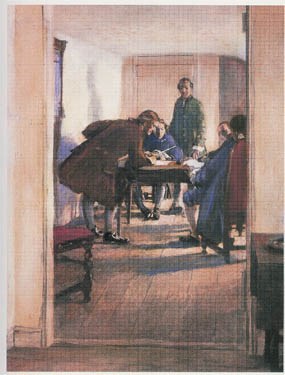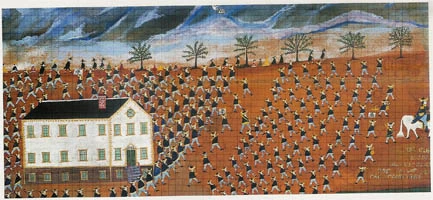
The seeds of John Glover’s leadership and military skills that blossomed during the Revolutionary War are evident in his early life in Marblehead, Massachusetts, the foremost commercial fishing port in North America. An ambitious and self-made man, Glover rose from humble beginnings and had started to build his fleet of fishing schooners by the age of thirty-one. The short, stocky Marbleheader even commanded some of his vessels to the Newfoundland coast, experiencing the dangers of the long and stormy voyages along with his men. Involved heavily in the fishing industry with his large fleet, Glover traded with Spain and Portugal, as well as the West Indies. A man of energy and business ability, he soon reached a prominent position in the close-knit mercantile “codfish” aristocracy, and had earned the respect of all levels of Marblehead society. In 1760, at the age of 28, Glover entered the political arena, joining the local Whigs in opposing Britain’s encroachment upon the political and commercial right of the colonies. Enraged by the Boston massacre of 1770, he united with other Whigs and wrested control of town government from the pro-British faction. In 1774, he became a member of the Committee of Correspondence which spread information and coordinated anti-British action across the colonies. Additionally, he joined the local Committee of Inspection that enforced the prohibitions on trade with England that had been passed by the First Continental Congress. As war seemed imminent, Glover, a militia officer since 1759, was commissioned a colonel of the reformed Massachusetts regiment which would become the 14th Continental Regiment, the “Marbleheaders.” Glover raised ten companies of some 500 fishermen and sailors, a few of who were Spanish, Native American, Jewish, and African-American. Those men -- many of whom Glover knew personally -- united under the power of his command. In late June 1775, armed with a pair of silver pistols and a sword, Colonel Glover led his troops from Marblehead to the American camp at Cambridge, helping to bottle up the British army in Boston. In addition, during that tense first summer of the war, he directed the building of forts and defenses along the Massachusetts coast to repel British attempts to press men and gather supplies. Under General Washington’s command, he led the project to convert maritime vessels into warships, or “Washington’s Schooners,” the first American naval fleet. 
Courtesy of the New York State Historical Association, Cooperstown, N.Y. Need to navigate around the exhibit? Here are some links for you to follow. Overlooked Hero: John Glover and the American Revolution |
Last updated: January 9, 2014
